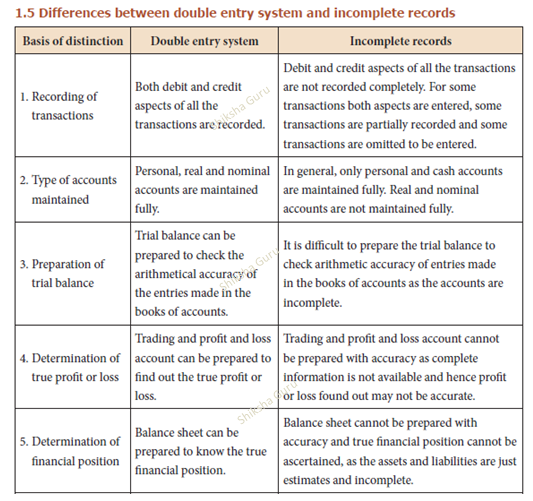Goodwill in Partnership Accounts - TN State Board 12th Accountancy Book Back Solution Guide
Chapter 4 Goodwill in Partnership Accounts
I. Choose the correct answer
1. Which of the following statements
is true?
(a) Goodwill is an intangible
asset (b) Goodwill is a current asset
(c)
Goodwill is a fictitious asset (d) Goodwill cannot be acquired
Answer:
(a) Goodwill is an intangible asset
2. Super profit is
the difference between
(a) Capital
employed and average profit (b) Assets and liabilities
(c) Average
profit and normal profit (d) Current year’s profit and average profit
Answer:
(c) Average profit and normal profit
3. The average rate
of return of similar concerns is considered as
(a) Average
profit (b) Normal rate of return
(c) Expected
rate of return (d) None of these
Answer:
(b) Normal rate of return
4. Which of the
following is true?
(a)
Super profit = Total profit / number of years
(b)
Super profit = Weighted profit / number of years
(c)
Super profit = Average profit – Normal profit
(d) Super profit = Average profit
× Years of purchase
5. Identify the
incorrect pair
(a)
Goodwill under Average profit method - Average profit × Number of years of
purchase
(b)
Goodwill under Super profit method - Super profit × Number of years of purchase
(c)
Goodwill under Annuity method - Average profit × Present value annuity factor
(d) Goodwill under Weighted
average - Weighted average profit × Number of years of profit method purchase
6. When the average
profit is ₹ 25,000 and the normal profit is ₹ 15,000, super profit is
(a) ₹ 25,000
(b) ₹ 5,000 (c) ₹ 10,000 (d) ₹ 15,000
7. Book profit of
2017 is ₹ 35,000; non-recurring income included in the profit is ₹ 1,000 and
abnormal loss charged in the year 2017 was ₹ 2,000, then the adjusted profit is
(a) ₹ 36,000 (b)
₹ 35,000
(c) ₹ 38,000 (d)
₹ 34,000
Answer:
(a) ₹ 36,000
8. The total
capitalised value of a business is ₹ 1,00,000; assets are ₹ 1,50,000 and
liabilities are ₹ 80,000. The value of goodwill as per the capitalisation
method will be
(a) ₹ 40,000 (b) ₹ 70,000
(c) ₹ 1,00,000 (d) ₹ 30,000
Answer:
(d) ₹ 30,000
II Very short answer questions
12th Standard Chapter 4 Question No.1
What
is goodwill?
Answer:
Goodwill
is the good name or reputation of the business which brings benefit to the
business. It enables the business to earn more profit. It is the present value
of a firm’s future excess earnings. It is an intangible asset as it has no
physical existence.
12th Standard Chapter 4 Question No.2
What
is acquired goodwill?
Answer:
Goodwill
acquired by making payment in cash or kind is called acquired or purchased
goodwill. When a firm purchases an existing business, the price paid for
purchase of such business may exceed the net assets (Assets – Liabilities) of
the business acquired. The excess of purchase consideration over the value of
net assets acquired is treated as acquired goodwill.
12th Standard Chapter 4 Question No.3
What
is super profit?
Answer:
Super profit is the base for calculation of the value of goodwill. Super profit is the excess of average
profit over the normal profit of a business.
Super profit = Average profit – Normal profit
What is normal rate of return?
Answer:
It is the rate
at which profit is earned by similar business entities in the industry under
normal circumstances.
State any two circumstances under which goodwill of
a partnership firm is valued.
Answer:
Following are the circumstances that require
valuation of goodwill of partnership firms in order to protect the rights of
the partners:
(i) When there is a change in the profit sharing ratio
(ii) When a new partner is admitted into
a firm
(iii) When an existing partner retires from the firm or when a partner dies
(iv) When a partnership firm is dissolved
III. Short answer questions
1. State any six factors determining
goodwill.
Answer:
- Profitability of the firm
- Favourable location of the business enterprise
- Good quality of goods or services offered
- Tenure of the business enterprise
- Efficiency of management
- Degree of competition
12th Standard Chapter 4 Short Answer Question No.2
How
is goodwill calculated under the super profits method?
Answer:
(i) Purchase of super profit method
Under this method, goodwill is
calculated by multiplying the super profit by a certain number of years of
purchase.
Goodwill = Super profit × Number of years of purchase
(ii) Annuity method
Under this method, value of
goodwill is calculated by multiplying the super profit with the present value
of annuity.
Goodwill
= Super profit × Present value annuity factor
(iii) Capitalisation
of super profit method
Under this method, value of goodwill is calculated by capitalising the super profit at normal rate of return, that is, goodwill is the capitalised value of super profit.
12th Standard Chapter 4 Short Answer Question No.3
How
is the value of goodwill calculated under the capitalisation method?
Under this
method, goodwill is the excess of capitalised value of average profit of the
business over the actual capital employed in the business.
Goodwill = Total capitalised value of the business – Actual capital employed
The total capitalised value of the business is calculated by capitalising the average profits on the basis of the normal rate of return.
Actual capital employed = Fixed assets
(excluding goodwill) + Current assets – Current liabilities
Compute average profit from the following information:
Goodwill = Average Profit x Number of years of Purchase
IV. Exercises
Answer:
Answer:
12th Standard Chapter 4 Exercise No.3
Answer:
12th Standard Chapter 4 Exercise No.4
Answer:
Answer:
Answer:































Comments
Post a Comment